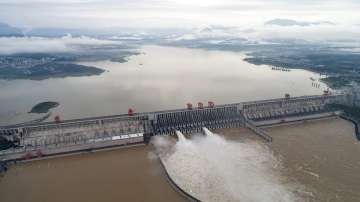Three Gorges in China: What you should know about the massive dam that is slowing Earth's rotation
Dislocating over a million people, the world's largest hydropower project holds nearly 42 billion tonnes of world, creating a shift in mass that is elongating the day by 0.06 microseconds.

Dams often attract significant national and international controversies, yet few dams would come as close as China's Three Gorges Dam, the world's largest hydropower project. The massive dam has been touted as an accelerating for the Chinese economy, as well as an efficient means for flood control and power generation. However, a major highlight of the dam is that it has effectively slowed down the rotation of the earth due to the sheer amount of water it holds.
Making the world's largest dam was obviously going to be expensive, and by some counts, the cost of constructing the Three Gorges Dam, by some counts, went up as high as $37 billion. It took nearly two decades to build completely and caused over a million people along the Yangtze river to relocate.
Despite China's claims that it has been successful in playing an essential role in intercepting floodwaters, the Three Gorges has been mired in controversy largely surrounding the environmental hazards it poses, including water pollution and flood control. Even today, China is grappling with heavy rains and severe flooding that further raise questions on the dam's efficiency.
Here are some interesting facts that you should know about the Three Gorges Dam in China:
The massive size of the dam
Regardless of its controversies, the Three Gorges Dam is an awe-inspiring creation that is 181 metres tall and 2.33 km wide across the Yangtze River. According to NASA, the massive dam is even visible to the naked eye from space. Additionally, it has a power generating capacity of over 22,500 megawatts, three times more than the largest dam in the United States.
Landslides and flood control
When plans for the creation of the dam opened in 1992, many scientists warned that it could trigger landslides due to increasing pressure on the surrounding island and threaten the biodiversity. In 2003, 700 million cubic feet or rock entered the Qinggan River, 2 km away from the Yangtze. The resultant water waves killed 14 people.
Despite this, the China Yangtze Three Gorges Development Corporation (CTGPC) raised the water level from 445 feet (135 m) to 512 feet (156 m) in its reservoir, triggering dozens of landslides. This stems from the dam's reported inability to control large amounts of floodwaters during the rainy season. In 2020, three flood waves hit the Three Gorges dam, causing it to open its sluice gates that have reportedly exacerbated floods downstream.
Poyang Lake, in Jiangxi province, reached its highest level in history, surpassing the levels during the 1998 floods that killed over 3,000 people. Since then, the Yangtze river has grappled with a surge of floods that have killed hundreds and displaced millions in several parts of China, leading to more doubts on the efficiency of the dam. Experts say that while it can withstand small floods, it is unable to prevent major floods caused by incessant rainfall in the Yangtze.
An environmental catastrophe?
In the creation of the dam's massive reservoir, over 1.4 million people have been displaced, their homes have been destroyed and numerous farmlands have been flooded. Moreover, two cities and over 100 towns and 1600 villages along the Yangtze river banks have been submerged by the reservoir. China recorded one of the worst floods in 2010, which killed 392 people.
According to Chinese state media in 2007, many experts have warned about a series of ecological hazards, including landslides and pollution, amounting to an environmental 'catastrophe'. The weight of the water reportedly eroded significant portions of the Yangtze river banks and triggered waterwaves as high as 50 metres.
The dam is placed over two major fault lines, and is blamed for a surge of earthquakes in the region. In 2003, a large chunk of a mountain broke away into the river, killing 24 people and destroying hundreds of homes. The dam's safety was further cast in doubt when reports of cracks on the dam's concrete face surfaced, which increased the risk of leaking.
It should also be noted that China is home to a large number of flora and fauna species. The construction of the massive dam has threatened the biodiversity of the area by endangering several plant, insect, fish and animal species by fuelling deforestation and pollution. According to some reports, as many as 57 plant species have been endangered, along with 400 others, by flooding and reduced water flow. The massive dam has also excerbated to the decline of the baiji dolphin, a rare specie considered functionally extinct.
Chinese state media also reported that that the Three Gorges dam has fuelled drought and disease, most notably as the Yangtze river reported its lowest level at 142 years in 2008. Decreased water flow has already affected several households and contaminated fresh water.
How the dam is affecting earth's duration?
National Aeronautics and Space Administration (NASA) scientists in 2005 calculated that the controversial Chinese dam is responsible for slowing the rotation of the earth. There are different factors that affect the earth's rotation, such as winds, earthquakes, climated change and even the position of the moon.
The dam's reservoir holds a massive 42 billion tonnes of water, causing the earth to lose a bit of momentum while rotating. As a result of the shift in mass, the length of a day is elongated by 0.06 microseconds. It is the only dam in the world that has affected the rotation of the earth so significantly. The Three Gorges dam makes the Earth only very slightly more round in the middle and flat on the top, according to NASA.
ALSO READ | China: 11 dead, 27 missing in flooding around Beijing after days of rain, says state media report